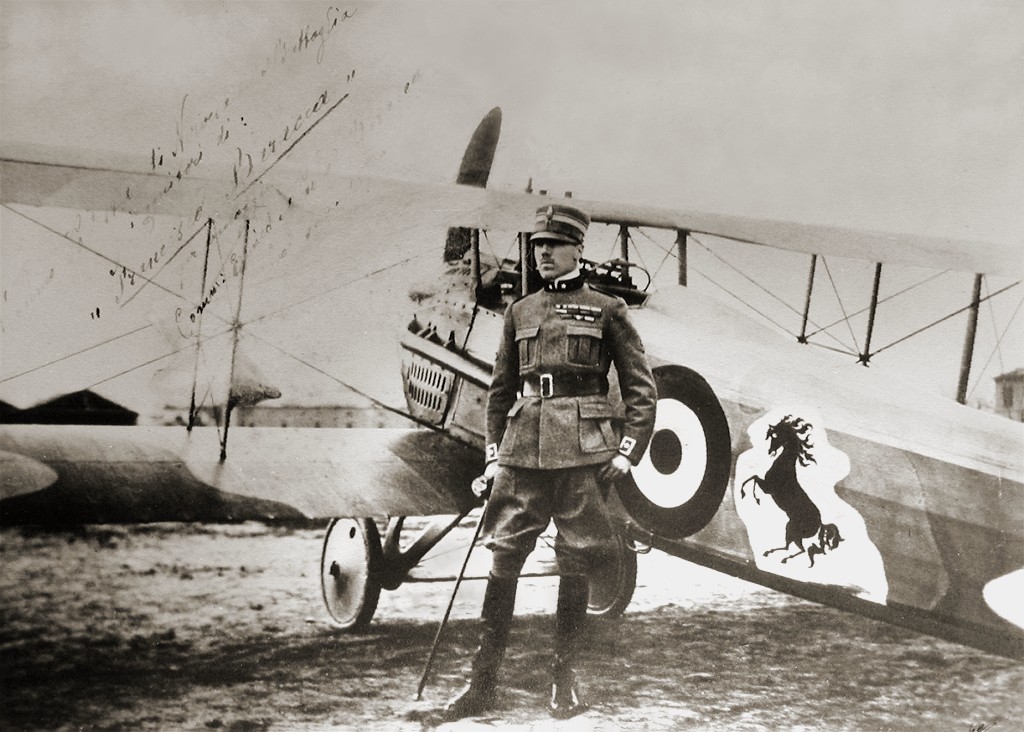Last month Susan and I were getting a few things at the Overland Park, Kansas branch of Whole Foods (a moderately trendy grocery store recently purchased by Amazon.com). As we piled our stuff in the back of Susan’s car, I quietly pointed out to her that a white roadster idling to our right in the parking lot was a Ferrari. This is no surprise in Whole Foods, and certainly no surprise in Johnson County, Kansas. Susan paused to take a quick picture with her cellphone, and we pulled away.
Being the aviation geek that I am, I can never resist pointing out to anyone who’s around at the time, that the prancing horse symbol was presented to Enzo Ferrari by the mother of an Italian flying ace after the First World War. I first read that in a LION annual sometime in the 1960s, I’m sure.
I could not remember the name of the flyer involved. However, once I looked him up, I thought a blog post might be in order, since the story is quite interesting.

The flyer in question was Count Francesco Baracca. He was born into a wealthy family in 1888 in Lugo di Romagna, in the province of Ravenna. He entered the military academy of Modena in 1907, and took up equestrianism as a release from academic study. He was commissioned into a cavalry regiment, and like several cavalry officers in many armies of the period, got the aviation bug. He went to Reims (France) to learn to fly in 1912. With his newly-acquired pilot’s license he returned to Italy and joined the Battaglione Aviatori.
Baracca converted to Nieuport 10s and was a member of the 8a Squadriglia Nieuport when Italy entered the First World War. He subsequently switched to the lighter single-seat Nieuport 11 Bébé and scored Italy’s first aerial victory, on April 7, 1916
Baracca also flew the Nieuport 17, SPAD VII and SPAD XIII in combat. The emblem of the prancing black horse (part of his family’s coat of arms) was first seen on his Nieuport 17 in 1917. He adopted the Griffin emblem for the 91st Squadriglia, although several pilots used both emblems in deference to their commander.
In early 1918 Baracca was one of a number of pilots, including two other aces, ordered to carry out trials of the Ansaldo A.1. The A.1 (later named Balilla after an Italian folk hero) was Italy’s only contemporary fighter aircraft of domestic design and manufacture. Baracca found his time away from the front extremely frustrating and after some lobbying managed to return to combat.
His score had risen to 34 enemy aircraft destroyed when he failed to return from a ground attack sortie on 19th June, 1918. There are a few conflicting stories, some of which were no doubt written for propaganda purposes on both sides, but following research in Austro-Hungarian archives it seems likely that he was killed by the rear-gunner of an Austrian two-seater Phönix which he was attacking.
After the war, the Francesco Baracca Museum was opened in his former home. Among other mementos such as uniforms, medals and aerial trophies (including the rudders and guns taken from shot down aircraft) was a SPAD VII, once flown by Baracca himself. The SPAD was removed from the Baracca museum and restored several years ago by members of the GAVS (Gruppo Amici Velivoli Storici – the Italian aeronautical preservation society). The Baracca museum has a fascinating website at www.museobaracca.it and the GAVS at http://gavs.it/


A young racing driver named Enzo Ferrari had allegedly (according to a couple of websites) met Baracca during the First World War. He certainly met Count Enrico and Countess Paolina (Francesco’s parents) in 1923. Baracca’s mother presented the Cavallino Rampante emblem to Ferrari, telling him it would bring him good luck. Ferrari added the yellow background of Modena, and thus another legend was born.
Since I am a product of that era I find the early 60s Ferrari 250 series racing cars to be things of great beauty, and thus feel no other excuse is necessary to include a picture or two.
I think I still have my old Corgi die-cast model of the 250LM.

CC BY-SA 3.0 via Wikimedia Commons
Anfd finally, Willy Mairesse charging round the Nürburgring in a 250P in 1963. You can see a certain emblem quite clearly.

(Lothar Spurzem -CC-by-sa/2.0/de via Wikimedia Commons)
